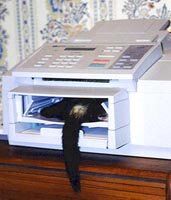-
- Note:
- These articles and images are copyrighted and may not be reprinted, re-used, reposted, copied, or otherwise distributed without permission from the author.
Disclaimer:
You should not rely on the veterinary advice or information provided on this site for diagnosis or treatment of any specific situation. Always consult your own veterinarian for specific advice concerning the medical condition or treatment of your own pet or animal.
 - Outgoing ferret fax (Morgan)
|
Curiosity Could Kill the Ferret
© Erika Matulich, Ph.D.
One day I noticed a funny noise coming from the washing machine. Thinking the load might be unbalanced, I opened the lid. The spin cycle was just about to start, and there was Bobbin, bobbing up and down trying to keep her head above the soapy water. I just about had a heart attack!
Are ferrets brilliant strategists who always manage to get what they think they want? (They are, after all, related to the weasel.) Or are they foolhardy nincompoops who can't see danger when it's staring them in the face? Either way, you need to know the basics of ferret-proofing your home:
Ferrets have flexible skeletons that let them squeeze into tiny openings. Check for quarter-size (1-inch) holes in walls and furniture; behind and under appliances; under and in cabinets; in window frames and screens; and around plumbing fixtures and drainpipes. Also make sure a ferret can't squeeze through floor vents, dryer vents, mail slots, pet doors, and fireplace grates, dampers, and screens. Patch holes with duct tape until wood or wire can be used to permanently block them. A funny thing about ferrets and small holes: Ferrets always seem able to squeeze in, but then they can't get out!
Ferret-proof couches, upholstered furniture, and mattresses by stapling hardboard, Masonite, or heavy-duty fabric to the bottom—ferrets like to climb inside, scratch up stuffing, and take long naps! Be careful with recliner chairs and sleeper sofas, as ferrets crawl inside and can get crushed. Recliners are a leading cause of accidental death in ferrets. It is best not to have them in the house; if you do, make sure they are kept upright when not in use. Keep stereo speakers out of reach, and do not use a rocking chair while ferrets are out playing.
Block off gaps around all appliances—as well as water heaters, air conditioners, fans, and fireplaces—so ferrets have no access to wires, rubber, fiberglass insulation, motors, fan blades, or moving parts. I once took the front grill off my refrigerator for cleaning, and Sweet Pea scooted under the fridge. I could not lure her out with treats; finally I had to hook a hanger around her collar and pull her out!
Some ferrets love to chew electrical cords; others like to investigate exposed outlets. Spray cords with bitter apple or with pepper spray, or cover them with tubing. Cover all outlets (covers can be found in many stores with baby supplies). My ferrets love to play on the power strips for my computer, so I have mounted the strips up high on the wall.
Many ferrets can open cabinet doors and drawers. Bear is my household drawer opener; the other ferrets wait for him to do his job! Remove toxic items from your cabinets before your ferret does, or else ferret-proof the cabinets with heavy-duty magnetic catches, cabinet clasps, or baby-proof latches. Look carefully before you close your refrigerator, shut the dishwasher, run the trash compactor, or take out the garbage. Paper towel rolls can be deadly if your ferret gets a head wedged in the tube. Playing with plastic grocery bags is tremendous fun for ferrets but should be supervised. (I cut the handles and corners off plastic bags to keep my fuzzies safe.)
Do not allow your ferret access to the laundry room. Check clothes before loading, and look in the washer or dryer before starting the cycle. Bobbin got washed because she was sleeping in some jeans I had hurriedly stuffed in the washer. Fortunately, she survived. Ferrets will not survive a trip through the dryer.
Bathroom dangers are similar to kitchen dangers. Secure cabinet doors and lower drawers. Keep toilet seats down and bathtubs empty; more than one ferret has drowned. Make sure ferrets can't reach the soap—eating it causes intestinal problems. Ferrets like to push cardboard toilet paper tubes around with their nose, but they often get their head jammed in the tube and can suffocate or choke to death on saliva. Cut the tubes open, or discard them safely.
Check windows and sliding doors—are they closed and locked? Gizmo can push these open. Are screens sturdy and intact? A ferret can quickly make a small hole larger, and Sweet Pea can slash through screens with no starter holes.
Ferrets do not have the ability to land safely on their feet in a fall, so they should not be allowed access to high places. Check for the climbability of draperies, fabric-covered furniture, wicker, screens, picture frames, etc. I once found Critter clinging like Velcro 6 feet up a wall; she had climbed the bamboo-textured wallpaper. Some ferrets will climb by wedging themselves between the wall and the closest piece of furniture, and then mysteriously appear on top of, say, a china cabinet.
Put these items out of a ferret's reach: houseplants, sponges, people food, gum, rawhide, dog food, birdseed, rubber bands, pencil erasers, candy, and Styrofoam packing peanuts.
Remember that ferret-proofing is an ongoing process, as ferrets devise new ways to explore the unknown. Constantly recheck your ferret-proofing efforts, especially when introducing a new ferret friend to the family.
And Bobbin? She was pretty ill for a while after her washing-machine adventure, but her fur was really white!
|